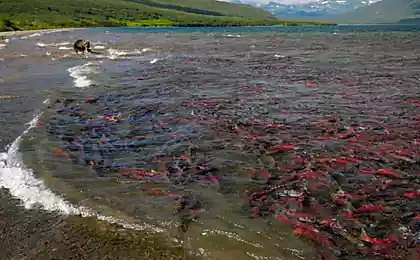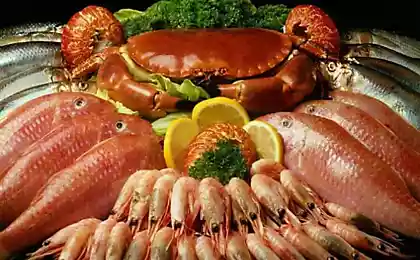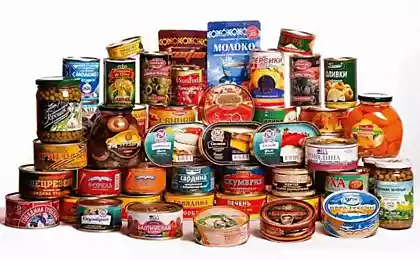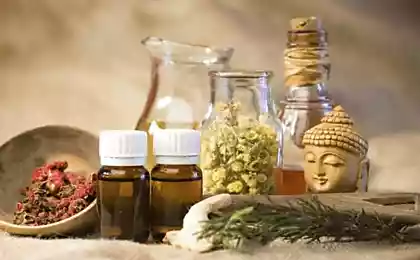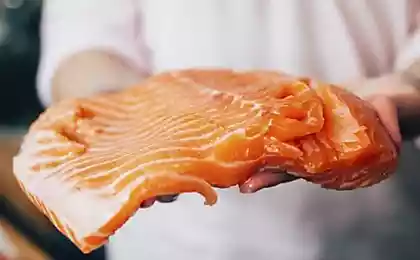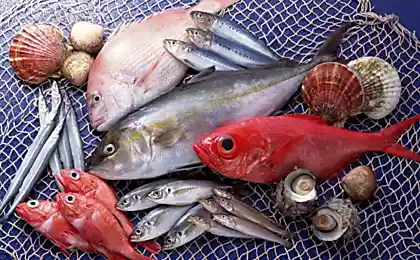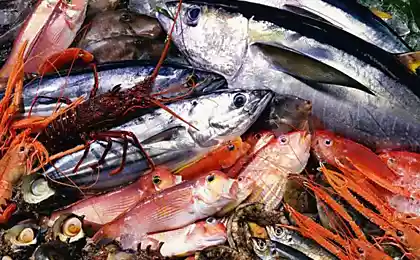798
That's what we sell under the guise of noble fish
Often in stores the category "economy" there are very good canned fish with a strange inscription "SPAWNING CHANGES". It's beautiful to look at canned salmon — chum, pink salmon, salmon, etc. (not sprat or capelin!), from natural habitat – the far East (not to Norwegian salmon grown in artificial conditions!), an impeccable place of production near the place of fishing — the island of Sakhalin, the Kuril Islands (this is not a factory for fish processing in the suburbs!).

What usually thinks, looking at these beautiful cans, the usual buyer? Here is a list of answers (poll of friends):
"Spawning change is good or bad"?
Pacific salmons — humpback salmon, chum salmon, Chinook salmon, sockeye, SIM live alone the cycle in which spawning is the pinnacle of success in life. To spawn these fish are prepared on conscience – gaining weight and strength necessary to go against the current of rapid rivers. Do not stop salmons on the way no fresh water rivers or small shoals or waterfalls and rapids. Through the rifts they crawl on their bellies, sometimes sticking out of the water his back, and waterfalls stormed, jumping up to a height of 2-3 meters.
If failed the first attempt, the fish, after resting, repeat it again and again until, until the obstacle will not be conquered. Entering the river a strong, well-fed fish, salmon first, "play", high jumping out of the water. But as you move upstream, jumping it becoming less and less. Reduced movement speed, but the salmon with maniacal persistence continue to move forward to the places of their death.
In breeding period during the transition to fresh water, salmon stop feeding, their body undergoes irreversible changes. Changes in physiological condition affect all internal organs: liver, stomach and intestines shrink, cease to stand out digestive enzymes, bile ceases to develop, protein their bodies are destroyed, they lose the ability to digest food and to synthesize new proteins, the meat is flabby and watery, the amount of fat in the muscles is sharply reduced.
The autopsy spawned fish revealed complete destruction of the immune system, resulting in a short period of time "picks up" a huge number of bacteria, fungi, parasites that are in the water. They find ulcers, kidney damage, huge adrenal glands and enormously high blood levels of glucocorticoids.
The ichthyologists have long known that the cause of death of Pacific salmon after spawning is not the exhaustion, and the inevitable, almost instantaneous aging process. The program is embedded in their genetic code, formed for millennia. Following a genetically specified program, far-Eastern salmons, spawn even in a quiet (no waterfalls), the short rivers of Sakhalin or Kamchatka, not spending half of the fat accumulated in the Pacific ocean in the fattening period, in two to four weeks to die "of old age".
Mechanism aging instant start programmed release during the mating period hormones related to the corticosteroids. The levels of these hormones usually increases under stress, hunger (in humans too). In many species of Pacific salmon, the release of the glucocorticoids occurs at the first SIP of fresh water.
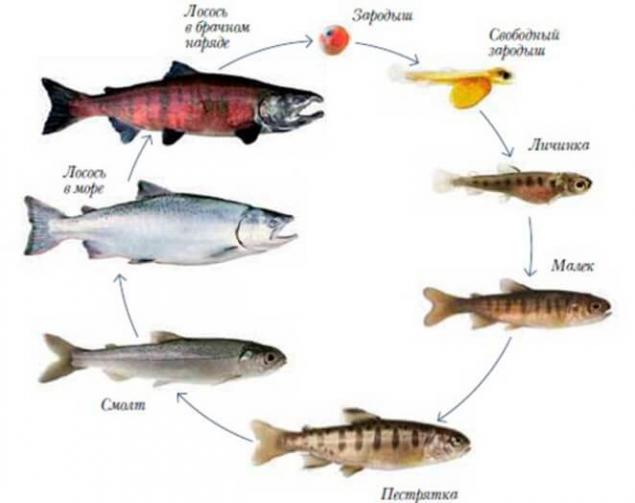
Recall that glucocorticoids (from the Greek word glykys – sweet, cortex — cortex) are hormones produced in the adrenal cortex. The most important of these hormones is cortisol, whose main task – keeping the level of glucose in the blood. Cortisol stimulates the breakdown of protein bodies and turning them into glucose, thereby increasing the concentration of glucose in the blood during starvation.
In addition, glucocorticoids "hinder" the immune system to respond adequately to the introduction into the body of foreign organisms and substances. They block the inflammatory response, promote the destruction of the immune system and as a result, the body feels no pain when the breakup of the body, and the introduction of infection.
In humans, short-term moderate release of cortisol during times of stress, danger, hunger, helping to protect the brain from destruction and save lives, and protracted killing. Heart attacks or strokes are often the result of cortisol release under stress.
In addition to diseases in salmon come, and terrible changes at the DNA level that affect their appearance: the sky, the jaw, the teeth change, changing scales, the skeleton. Males develop a prominent hump, you receive the Fang, scales, sinks into the skin almost fused with it, radically changing its color. Females also is changing the body shape, the color changes.
While these salmon (accent the 3rd syllable), like pink salmon, sockeye salmon, chum salmon etc. are at sea, the meat has different shades of red. During spawning, the meat becomes white and friable.
By the way, salmon fish, meat of red color is not "red fish". Red fish is a fish is the sturgeon, although the meat its white color. It was called "red" because in the old days it referred to all the rare, expensive and beautiful.

After spawning begins the mass death of spawned fish. The most depleted are already dying on the spawning grounds, while others are carried over and die on the way to the mouth. The bottom and banks of the river covered by dead fish in the far East called "Sanka".

If fish from the salmon family to remove the adrenal glands, it is able to live another year after spawning, and if the operation is to expose the young fish, its life is extended twice.
The smell on the river is disgusting and not appetizing. This abundant food is going to a lot of gulls, crows and various animals. For them it is a feast.
For them but not for us. For us is a carcass. I hope it is clear:
Canned fish "spawning changes" is a canned food from falling or dying fish.
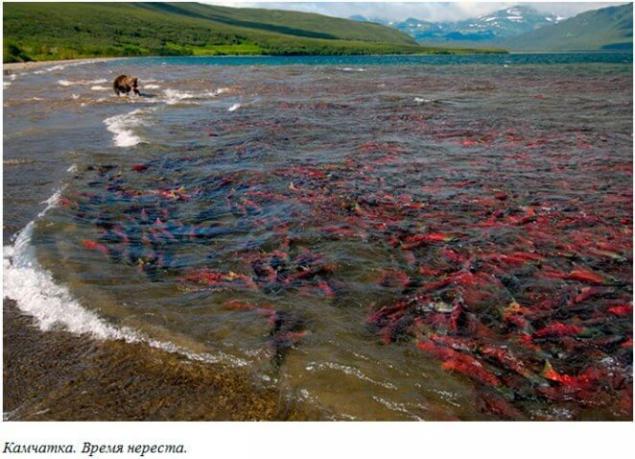
Some enterprising people think that this fish, after appropriate treatment, should be so like our spoiled population that it can be sold at a price of valuable fish varieties. Spawned fish, raked and taken away for further processing.
Surprisingly, to produce canned fish with the initial spawning changes allows the GOST. The manufacturer is not obliged to put this information on labels (although some place), but he is obliged in the labeling of canned foods on the lid of the jar to specify product codes for fish with spawning changes.
Therefore, it is necessary to type in the search engine "spawning changes" and, judging by the ads, you will find that entrepreneurs are actively selling and buying frozen fish with spawning changes, while not specifying the degree of change.
Buy canned fish with spawning changes, very simple, even if you are aware that it is bad and don't want to buy them. On the label of such information and product codes is not for buyers. Many of them either don't know or know but don't know where they are located or where to find them.
But even those buyers who want to understand the product codes, this can not do! Try to find the "Register product codes for canned fish"! This information as though classified.
The registry is introduced according to the order № 45 of the Ministry of Agriculture (Federal Agency for fishery) July 20, 2004 (which was later additions to the registry), based on document developed by Federal state unitary enterprise all-Russian research Institute of fisheries and Oceanography (VNIRO).
Codes fish products
In the manufacture of canned Pacific salmon (natural or with butter) manufacturers should use the GOST 3256-2013 "CANNED PACIFIC SALMON in NATURAL AND NATURAL WITH OIL". In this GOST indicated that for the labelling of cans containing fish or fish components, you should use the GOST 11771-93.
Open the GOST 11771-93. Paragraph 1.17 GOST reads: the markings must be made: on the lid of cans by extrusion or indelible ink on the outer side of the bottom or lid.
Signs of symbols is applied in three rows:
In accordance with paragraph 1.18 GOST 11771-93, all markings should be clear.
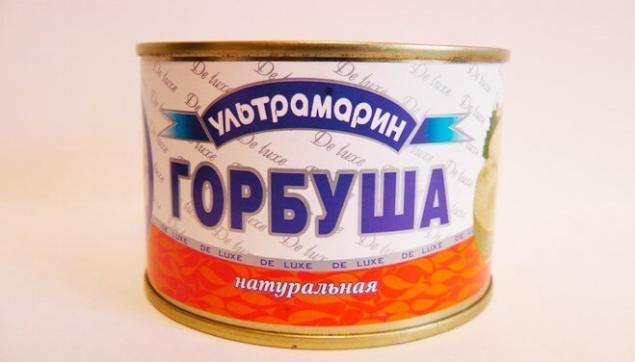

The photo above shows the marking of canned fish "pink Salmon". All informational signs engraved on the Bank from the inside and very clearly, and it is an indication that tin was made in the factory and not homemade. All the signs are very clear. It's easy to read that the Bank rolled 20 August 2014 (the top line). Product code product 85Д (the first three characters of the second line), plant code 267 (3 of the last character of second line) – what is this enterprise, alas, do not know. The can is sealed during the first shift (the bottom line).
The letter "R" at the beginning of the third row or beginning of the second line (if marking in two rows) indicates that the product relates to the fishing industry, and its product code to be found in the document "Registry of the assortment of characters canned and preserved fish and non-fish objects of fishery products".
Product code banks "85Д" – the registry belongs to the natural pink salmon, i.e. the information on the label and the information stored in the product code are the same. However, it is not always so.
Look at the Bank below.

Trout in tomato sauce from the brand "Master and commander". On the Bank written in large letters "Trout in tomato sauce", and just below in small print (not visible) — "far Eastern salmon blanched in tomato sauce".
Now look at the commodity code that is stamped on the lid of the jar. There is a date, product code, too, is — "Г32". Open "Registry of the assortment of characters canned and preserved fish and non-fish objects of fishery products", find the code "Г32" belongs to the canned form of "far-Eastern Salmon with spawning changes, blanched in tomato sauce"!!! A fish you wanted to buy?
The true contents of the jar does not match the label. The label hid from us bad information, as some customers are already aware that this spawning change. But the product codes are known only to rare professionals..
Driven codes canned Pacific salmon from the fish with spawning changes. Please note, quite a lot, although the Internet can I find information that fish with spawning changes has the code "C20".
C19 — Salmon with spawning changes natural
C20 — Salmon with spawning changes with natural spices
M13 — Salmon with spawning changes in tomato sauce
Х03 — Pacific Salmon with spawning changes natural
Д02 — Pacific Salmon with spawning changes natural flavored smoke the drug "Original"
З15 — Pacific Salmon with spawning changes fried in tomato sauce
Г32 — Pacific Salmon with spawning changes blanched in tomato sauce
У72 — Chum salmon with spawning changes natural
У97 - Chum salmon with spawning changes natural with the addition of flavored smoke the drug oil "the Original"
54A – Chum salmon with spawning changes with the addition of natural oil
55A – Chum salmon with spawning changes in jelly
And what do we do? To write to the phone product codes canned, which in any case can not buy?
Why are you even allowed to produce canned food from a terminally ill fish? Due to the lack of food when you can eat anything just not to starve to death? It seems that the times are not as severe. Then why we are fed, than in Stalin's time were fed only prisoners in death row dogs?
There are other issues. There is great probability that the fish with spawning changes sold not only in the form of canned food, but in frozen, salted or smoked? I'm sure some across the salty salmon with decaying meat and an unpleasant odor (it is aromatic in normal salmon!).
What the banks in which it is impossible to determine the quality of the fish? Because producers of such products makes no sense to "Shine" and specify not really the advertising information on the spawning changes. Such preserves quite a lot:


Riet is a way of cooking meat or fish, in which the animal long stew on a slow fire, in the resultant fat. The meat is then removed from the bone and mixed. A characteristic feature of rieta – fibrous structure.
Because fish-processing industry out of trust, then, perhaps, I think, to buy such products or not, even if we offend conscientious manufacturers.
On TV occasionally show footage, after spawning river banks littered with spawned fish. For many, even the question arises: "why this fish kill, and not send in a distribution network or to distribute for free?".
I hope you have such question will not arise.
The unscrupulous manufacturers of very many ways to deceive even the watchful, knowledgeable buyer.
Look at the photo below.
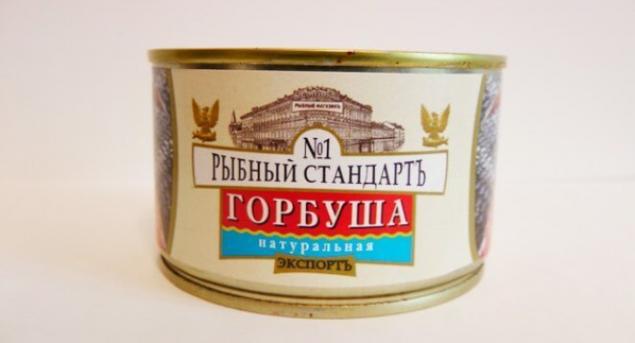
That only do not write on the label to lull our vigilance: "fish standard", "exports"! And the information placed on the side of the label this can also inspire confidence:
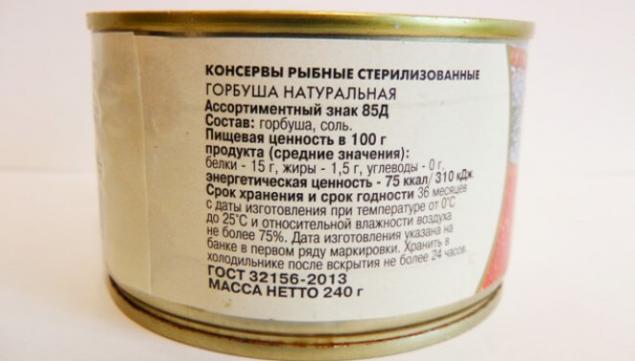
Everything is perfect: we already know in the registry product code 85Д corresponds to the natural salmon. GOST 32156-2013 specified is also correct, except that it States that the marking must be performed according to GOST 11771-93 on the lid of cans by extrusion. Look at the cover:
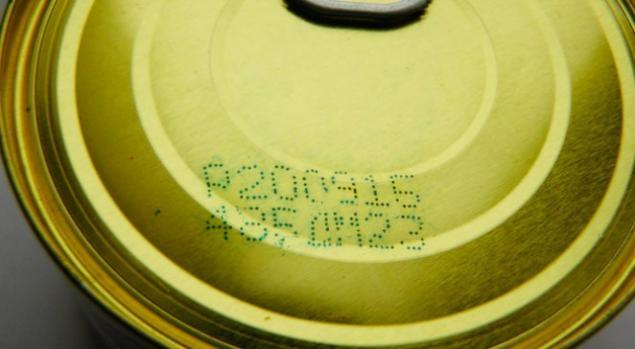
But in this photo the markings photographed closer, and it became clearly evident that the numbers are fuzzy, smeared markings, and must be done with indelible paint. May even have erased the old marking, and swung, but the traces of the "blurring" of the old markings left? Some figures difficult to read: look at the second digit of the second row. Is a 3 or 8? Only when the increase shows that this is figure 3, which tried to give the appearance of the number 8.
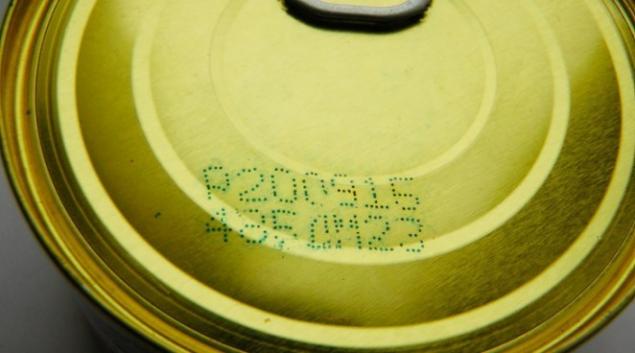
So what are those markings?
It turns out in GOST 11171-93 (paragraph 1.17.3) other marking is permitted for businesses that are equipped with imported marking or universal composters. In this case, the permitted signs of the legend applied to the cover in two rows.
First row:
Canned relate to the fishing industry (the first letter "P" in the top row).
In accordance with the registry product codes code pink natural – 85Д and code 35D belongs to the Pacific sardine (iwashi), blanched in oil-tomato filling.
But, on the labels banks says "Export". Product code pink-natural going for export, not "85Д" and "35D" (page 27 registry), and one letter "R"! That's her in the product code is not visible.
But the contents of cans of pink salmon natural in export production. The meat is dry and not tasty.

With the letter "R" in the product code at all eccentricities. In GOST 11171-93 in paragraphs 1.17 1.17.3 written and it is written that the letter "P" cannot be used as product codes. Then why in the "Register of marks assortment of canned and preserved fish and non-fish objects of fishery products" section 1.20 "For export" (page 59) indicates that the product code natural pink salmon – "R".
Whether the developers of the registry of FSUE "VNIRO" didn't read GOST 11771-93, there was still some additions to the registry that cannot be found, or for some other reason, but they are entered in the registry to indicate export of salmon natural the letter "P" which is not used in the product code.
The developers of GOST 11171-93 also have questions.
Why do we need different rules of formation of the marker codes with the different methods of marking? Is imported equipment is not able to mark according to the rules of paragraph 1.7 in GOST?
Hardly in all retail outlets have the technology of the fishing industry, is able to unravel the puzzle with the label of canned fish. And buyers to confuse even easier.
Maybe it's the salmon with spawning changes – her meat loses its redness and becomes light?
Normally, the color of canned pink salmon natural should be pale pink.
How such a marking like?
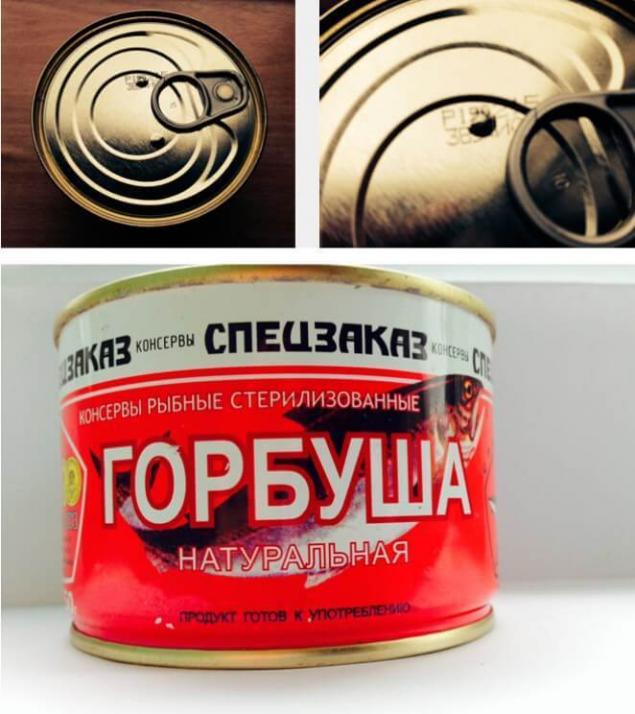
Though the label says "pink Salmon, but the code does not 85Д. In General, not readable, although the first two figures are visible (3-I change the product code with the numbers 8 starts)? Much you companies operating in three or four changes, you know? Though the right inner ring is labeled "1C", which probably means 1st shift. In a word, that the Bank is not clear.
A Phineas Barnum, who lived in the nineteenth century, suggested that the owner of plants, ships engaged in fishing of white salmon (what it's for salmon, we don't know) a good publicity stunt. By the time the owner opened his business, all of America was already inundated with pink salmon. White fish on a background of pink salmon looked stale and had gone bad.
For some 15% of future revenue Barnum found a simple and elegant solution suggested packing white salmon banks with the inscription: "the Only salmon that is not pink from contact with the packaging!" Canned goods were sold so well that the plants barely had time to cope with the number of orders. The royalties received for the idea, Barnum had until the end of life.
Certainly, the idea of selling white spawned salmon have also been very beneficial.
By the way, revealing a huge number of jars from different manufacturers with canned Pacific salmon fish, pink color fish anywhere virtually never been "seen". And the taste of fish from these cans were not like the taste of "valuable" fish. Sprat is much tastier.
The absence of GOST 11771-93 unambiguous labeling requirements canned fish, "illogical" the product codes in the registry codes, "closed" access to the registry product codes – all this suggests that buyers need to know what is inside the cans.
Specify some terms and names of fishes of the salmon family
Unfortunately, not so simple with the names of fish from the salmon family, very easy to get confused.
Salmon is the name of a family of fish. In its composition, freshwater fish species, and those that live in the sea and breed in fresh water. The most famous representatives: salmon, pink salmon, chum salmon, sockeye salmon, coho salmon, Chinook salmon, whitefish, Cisco, char, grayling, taimen, lenok, trout (trout), rainbow trout (rainbow trout), and others.
In the family of salmon fishes are a subfamily of the same name salmon in it — multiple births, as with freshwater fish, and marine spawning, which takes place in fresh water.
Famous genera of fishes of the salmon family, subfamily salmon:
Immature Atlantic salmon – salmon, in appearance little different from being in the same physiological condition of Pacific salmon. The marriage attire of this fish is also pronounced, but not to the same extent as in many Pacific relatives. The most significant change in spawning males.
Their silvery body, in the upper half of which have separate dark spots, dark on the sides and the head appear red and orange spots. Jaws elongate and bent, the lower jaw is formed a hook-like projection entering the notch of the upper jaw.
In nature, there are freshwater
Source: www.sethealth.ru/2016/10/19/%D0%B2%D0%BE%D1%82-%D1%87%D1%82%D0%BE-%D0%BD%D0%B0%D0%BC-%D0%BF%D1%80%D0%BE%D0%B4%D0%B0%D1%8E%D1%82-%D0%BF%D0%BE%D0%B4-%D0%B2%D0%B8%D0%B4%D0%BE%D0%BC-%D0%B1%D0%BB%D0%B0%D0%B3%D0%BE%D1%80%D0%BE%D0%B4/2/

What usually thinks, looking at these beautiful cans, the usual buyer? Here is a list of answers (poll of friends):
- Valuable salmon – great! It's not sardines!
- Canned food is produced on Sakhalin, the Kuril Islands! So not of Norwegian salmon are grown in artificial cages!
- Produced in Moscow and on Sakhalin, and the Kuril Islands! Great! It means fresh fish!
- Information on spawning changes made to the label, then it is permitted and even well – usually fish before spawning gaining fat.
"Spawning change is good or bad"?
Pacific salmons — humpback salmon, chum salmon, Chinook salmon, sockeye, SIM live alone the cycle in which spawning is the pinnacle of success in life. To spawn these fish are prepared on conscience – gaining weight and strength necessary to go against the current of rapid rivers. Do not stop salmons on the way no fresh water rivers or small shoals or waterfalls and rapids. Through the rifts they crawl on their bellies, sometimes sticking out of the water his back, and waterfalls stormed, jumping up to a height of 2-3 meters.
If failed the first attempt, the fish, after resting, repeat it again and again until, until the obstacle will not be conquered. Entering the river a strong, well-fed fish, salmon first, "play", high jumping out of the water. But as you move upstream, jumping it becoming less and less. Reduced movement speed, but the salmon with maniacal persistence continue to move forward to the places of their death.
In breeding period during the transition to fresh water, salmon stop feeding, their body undergoes irreversible changes. Changes in physiological condition affect all internal organs: liver, stomach and intestines shrink, cease to stand out digestive enzymes, bile ceases to develop, protein their bodies are destroyed, they lose the ability to digest food and to synthesize new proteins, the meat is flabby and watery, the amount of fat in the muscles is sharply reduced.
The autopsy spawned fish revealed complete destruction of the immune system, resulting in a short period of time "picks up" a huge number of bacteria, fungi, parasites that are in the water. They find ulcers, kidney damage, huge adrenal glands and enormously high blood levels of glucocorticoids.
The ichthyologists have long known that the cause of death of Pacific salmon after spawning is not the exhaustion, and the inevitable, almost instantaneous aging process. The program is embedded in their genetic code, formed for millennia. Following a genetically specified program, far-Eastern salmons, spawn even in a quiet (no waterfalls), the short rivers of Sakhalin or Kamchatka, not spending half of the fat accumulated in the Pacific ocean in the fattening period, in two to four weeks to die "of old age".
Mechanism aging instant start programmed release during the mating period hormones related to the corticosteroids. The levels of these hormones usually increases under stress, hunger (in humans too). In many species of Pacific salmon, the release of the glucocorticoids occurs at the first SIP of fresh water.

Recall that glucocorticoids (from the Greek word glykys – sweet, cortex — cortex) are hormones produced in the adrenal cortex. The most important of these hormones is cortisol, whose main task – keeping the level of glucose in the blood. Cortisol stimulates the breakdown of protein bodies and turning them into glucose, thereby increasing the concentration of glucose in the blood during starvation.
In addition, glucocorticoids "hinder" the immune system to respond adequately to the introduction into the body of foreign organisms and substances. They block the inflammatory response, promote the destruction of the immune system and as a result, the body feels no pain when the breakup of the body, and the introduction of infection.
In humans, short-term moderate release of cortisol during times of stress, danger, hunger, helping to protect the brain from destruction and save lives, and protracted killing. Heart attacks or strokes are often the result of cortisol release under stress.
In addition to diseases in salmon come, and terrible changes at the DNA level that affect their appearance: the sky, the jaw, the teeth change, changing scales, the skeleton. Males develop a prominent hump, you receive the Fang, scales, sinks into the skin almost fused with it, radically changing its color. Females also is changing the body shape, the color changes.
While these salmon (accent the 3rd syllable), like pink salmon, sockeye salmon, chum salmon etc. are at sea, the meat has different shades of red. During spawning, the meat becomes white and friable.
By the way, salmon fish, meat of red color is not "red fish". Red fish is a fish is the sturgeon, although the meat its white color. It was called "red" because in the old days it referred to all the rare, expensive and beautiful.

After spawning begins the mass death of spawned fish. The most depleted are already dying on the spawning grounds, while others are carried over and die on the way to the mouth. The bottom and banks of the river covered by dead fish in the far East called "Sanka".

If fish from the salmon family to remove the adrenal glands, it is able to live another year after spawning, and if the operation is to expose the young fish, its life is extended twice.
The smell on the river is disgusting and not appetizing. This abundant food is going to a lot of gulls, crows and various animals. For them it is a feast.
For them but not for us. For us is a carcass. I hope it is clear:
Canned fish "spawning changes" is a canned food from falling or dying fish.

Some enterprising people think that this fish, after appropriate treatment, should be so like our spoiled population that it can be sold at a price of valuable fish varieties. Spawned fish, raked and taken away for further processing.
Surprisingly, to produce canned fish with the initial spawning changes allows the GOST. The manufacturer is not obliged to put this information on labels (although some place), but he is obliged in the labeling of canned foods on the lid of the jar to specify product codes for fish with spawning changes.
Therefore, it is necessary to type in the search engine "spawning changes" and, judging by the ads, you will find that entrepreneurs are actively selling and buying frozen fish with spawning changes, while not specifying the degree of change.
Buy canned fish with spawning changes, very simple, even if you are aware that it is bad and don't want to buy them. On the label of such information and product codes is not for buyers. Many of them either don't know or know but don't know where they are located or where to find them.
But even those buyers who want to understand the product codes, this can not do! Try to find the "Register product codes for canned fish"! This information as though classified.
The registry is introduced according to the order № 45 of the Ministry of Agriculture (Federal Agency for fishery) July 20, 2004 (which was later additions to the registry), based on document developed by Federal state unitary enterprise all-Russian research Institute of fisheries and Oceanography (VNIRO).
Codes fish products
In the manufacture of canned Pacific salmon (natural or with butter) manufacturers should use the GOST 3256-2013 "CANNED PACIFIC SALMON in NATURAL AND NATURAL WITH OIL". In this GOST indicated that for the labelling of cans containing fish or fish components, you should use the GOST 11771-93.
Open the GOST 11771-93. Paragraph 1.17 GOST reads: the markings must be made: on the lid of cans by extrusion or indelible ink on the outer side of the bottom or lid.
Signs of symbols is applied in three rows:
- First row – date of production (date, month, year): number is two digits, e.g. 02; month in two digits; year – last two digits.
- Second row — assortment sign from 1 to 3 characters (numbers or letters, except the letter "R"); then the number of the plant – from 1 to 3 characters (numbers or letters);
- In the third row indicate the number of shifts – 1 sign, the index of fishing industry the letter R.
In accordance with paragraph 1.18 GOST 11771-93, all markings should be clear.


The photo above shows the marking of canned fish "pink Salmon". All informational signs engraved on the Bank from the inside and very clearly, and it is an indication that tin was made in the factory and not homemade. All the signs are very clear. It's easy to read that the Bank rolled 20 August 2014 (the top line). Product code product 85Д (the first three characters of the second line), plant code 267 (3 of the last character of second line) – what is this enterprise, alas, do not know. The can is sealed during the first shift (the bottom line).
The letter "R" at the beginning of the third row or beginning of the second line (if marking in two rows) indicates that the product relates to the fishing industry, and its product code to be found in the document "Registry of the assortment of characters canned and preserved fish and non-fish objects of fishery products".
Product code banks "85Д" – the registry belongs to the natural pink salmon, i.e. the information on the label and the information stored in the product code are the same. However, it is not always so.
Look at the Bank below.

Trout in tomato sauce from the brand "Master and commander". On the Bank written in large letters "Trout in tomato sauce", and just below in small print (not visible) — "far Eastern salmon blanched in tomato sauce".
Now look at the commodity code that is stamped on the lid of the jar. There is a date, product code, too, is — "Г32". Open "Registry of the assortment of characters canned and preserved fish and non-fish objects of fishery products", find the code "Г32" belongs to the canned form of "far-Eastern Salmon with spawning changes, blanched in tomato sauce"!!! A fish you wanted to buy?
The true contents of the jar does not match the label. The label hid from us bad information, as some customers are already aware that this spawning change. But the product codes are known only to rare professionals..
Driven codes canned Pacific salmon from the fish with spawning changes. Please note, quite a lot, although the Internet can I find information that fish with spawning changes has the code "C20".
C19 — Salmon with spawning changes natural
C20 — Salmon with spawning changes with natural spices
M13 — Salmon with spawning changes in tomato sauce
Х03 — Pacific Salmon with spawning changes natural
Д02 — Pacific Salmon with spawning changes natural flavored smoke the drug "Original"
З15 — Pacific Salmon with spawning changes fried in tomato sauce
Г32 — Pacific Salmon with spawning changes blanched in tomato sauce
У72 — Chum salmon with spawning changes natural
У97 - Chum salmon with spawning changes natural with the addition of flavored smoke the drug oil "the Original"
54A – Chum salmon with spawning changes with the addition of natural oil
55A – Chum salmon with spawning changes in jelly
And what do we do? To write to the phone product codes canned, which in any case can not buy?
Why are you even allowed to produce canned food from a terminally ill fish? Due to the lack of food when you can eat anything just not to starve to death? It seems that the times are not as severe. Then why we are fed, than in Stalin's time were fed only prisoners in death row dogs?
There are other issues. There is great probability that the fish with spawning changes sold not only in the form of canned food, but in frozen, salted or smoked? I'm sure some across the salty salmon with decaying meat and an unpleasant odor (it is aromatic in normal salmon!).
What the banks in which it is impossible to determine the quality of the fish? Because producers of such products makes no sense to "Shine" and specify not really the advertising information on the spawning changes. Such preserves quite a lot:
- Minced salmon natural.
- Minced natural of Pacific salmon with the addition of milk.
- Pate meat, liver, milk, and hearts of Pacific salmonids.
- Liver of sturgeon.
- Liver pate, milk, salmon caviar "Special".
- Milt Pacific salmon natural.
- Milt Pacific salmon with oil.
- Salmon with soy and carrots.
- Salmon with corn and carrots.
- Sausages fish.


Riet is a way of cooking meat or fish, in which the animal long stew on a slow fire, in the resultant fat. The meat is then removed from the bone and mixed. A characteristic feature of rieta – fibrous structure.
Because fish-processing industry out of trust, then, perhaps, I think, to buy such products or not, even if we offend conscientious manufacturers.
On TV occasionally show footage, after spawning river banks littered with spawned fish. For many, even the question arises: "why this fish kill, and not send in a distribution network or to distribute for free?".
I hope you have such question will not arise.
The unscrupulous manufacturers of very many ways to deceive even the watchful, knowledgeable buyer.
Look at the photo below.

That only do not write on the label to lull our vigilance: "fish standard", "exports"! And the information placed on the side of the label this can also inspire confidence:

Everything is perfect: we already know in the registry product code 85Д corresponds to the natural salmon. GOST 32156-2013 specified is also correct, except that it States that the marking must be performed according to GOST 11771-93 on the lid of cans by extrusion. Look at the cover:

But in this photo the markings photographed closer, and it became clearly evident that the numbers are fuzzy, smeared markings, and must be done with indelible paint. May even have erased the old marking, and swung, but the traces of the "blurring" of the old markings left? Some figures difficult to read: look at the second digit of the second row. Is a 3 or 8? Only when the increase shows that this is figure 3, which tried to give the appearance of the number 8.

So what are those markings?
It turns out in GOST 11171-93 (paragraph 1.17.3) other marking is permitted for businesses that are equipped with imported marking or universal composters. In this case, the permitted signs of the legend applied to the cover in two rows.
First row:
- Index the fishing industry the letter "R".
- Date of manufacture (day, month, year).
- Shift (for enterprises with single-shift work is allowed do not apply).
- Assortment sign – one to three digits (numbers and letters except the letter "R").
- The enterprise number of the manufacturer – up to three characters (numbers and letters).
Canned relate to the fishing industry (the first letter "P" in the top row).
- Manufacture date 20.09.2015.
- 4th shift (the first letter of the second row), do you believe that the enterprise 4 change?
- Product code 85Д (or 35D?) – it seems that the product code was trying to "fit" under the code pink natural.
- Enterprise M23.
In accordance with the registry product codes code pink natural – 85Д and code 35D belongs to the Pacific sardine (iwashi), blanched in oil-tomato filling.
But, on the labels banks says "Export". Product code pink-natural going for export, not "85Д" and "35D" (page 27 registry), and one letter "R"! That's her in the product code is not visible.
But the contents of cans of pink salmon natural in export production. The meat is dry and not tasty.

With the letter "R" in the product code at all eccentricities. In GOST 11171-93 in paragraphs 1.17 1.17.3 written and it is written that the letter "P" cannot be used as product codes. Then why in the "Register of marks assortment of canned and preserved fish and non-fish objects of fishery products" section 1.20 "For export" (page 59) indicates that the product code natural pink salmon – "R".
Whether the developers of the registry of FSUE "VNIRO" didn't read GOST 11771-93, there was still some additions to the registry that cannot be found, or for some other reason, but they are entered in the registry to indicate export of salmon natural the letter "P" which is not used in the product code.
The developers of GOST 11171-93 also have questions.
Why do we need different rules of formation of the marker codes with the different methods of marking? Is imported equipment is not able to mark according to the rules of paragraph 1.7 in GOST?
Hardly in all retail outlets have the technology of the fishing industry, is able to unravel the puzzle with the label of canned fish. And buyers to confuse even easier.
Maybe it's the salmon with spawning changes – her meat loses its redness and becomes light?
Normally, the color of canned pink salmon natural should be pale pink.
How such a marking like?

Though the label says "pink Salmon, but the code does not 85Д. In General, not readable, although the first two figures are visible (3-I change the product code with the numbers 8 starts)? Much you companies operating in three or four changes, you know? Though the right inner ring is labeled "1C", which probably means 1st shift. In a word, that the Bank is not clear.
A Phineas Barnum, who lived in the nineteenth century, suggested that the owner of plants, ships engaged in fishing of white salmon (what it's for salmon, we don't know) a good publicity stunt. By the time the owner opened his business, all of America was already inundated with pink salmon. White fish on a background of pink salmon looked stale and had gone bad.
For some 15% of future revenue Barnum found a simple and elegant solution suggested packing white salmon banks with the inscription: "the Only salmon that is not pink from contact with the packaging!" Canned goods were sold so well that the plants barely had time to cope with the number of orders. The royalties received for the idea, Barnum had until the end of life.
Certainly, the idea of selling white spawned salmon have also been very beneficial.
By the way, revealing a huge number of jars from different manufacturers with canned Pacific salmon fish, pink color fish anywhere virtually never been "seen". And the taste of fish from these cans were not like the taste of "valuable" fish. Sprat is much tastier.
The absence of GOST 11771-93 unambiguous labeling requirements canned fish, "illogical" the product codes in the registry codes, "closed" access to the registry product codes – all this suggests that buyers need to know what is inside the cans.
Specify some terms and names of fishes of the salmon family
Unfortunately, not so simple with the names of fish from the salmon family, very easy to get confused.
Salmon is the name of a family of fish. In its composition, freshwater fish species, and those that live in the sea and breed in fresh water. The most famous representatives: salmon, pink salmon, chum salmon, sockeye salmon, coho salmon, Chinook salmon, whitefish, Cisco, char, grayling, taimen, lenok, trout (trout), rainbow trout (rainbow trout), and others.
In the family of salmon fishes are a subfamily of the same name salmon in it — multiple births, as with freshwater fish, and marine spawning, which takes place in fresh water.
Famous genera of fishes of the salmon family, subfamily salmon:
- Pacific salmons – humpback salmon, chum salmon, SIMA, and nerka, Chinook salmon etc. Pacific salmon refers to salmon (other names — rainbow trout, Pacific salmon, Pacific salmon).
- Sakhalin sea trout (Celica) — live japonskom sea is to spawn in the rivers of Hokkaido, the southern Kuril Islands, Sakhalin and Primorye.
- Noble salmon – this genus is also called the "true salmon" or "salmon". The genus includes about 30 species. Some species live in fresh water, others live in seawater, but spawn in freshwater (this is the so-called entrance type of salmon).
Immature Atlantic salmon – salmon, in appearance little different from being in the same physiological condition of Pacific salmon. The marriage attire of this fish is also pronounced, but not to the same extent as in many Pacific relatives. The most significant change in spawning males.
Their silvery body, in the upper half of which have separate dark spots, dark on the sides and the head appear red and orange spots. Jaws elongate and bent, the lower jaw is formed a hook-like projection entering the notch of the upper jaw.
In nature, there are freshwater
Source: www.sethealth.ru/2016/10/19/%D0%B2%D0%BE%D1%82-%D1%87%D1%82%D0%BE-%D0%BD%D0%B0%D0%BC-%D0%BF%D1%80%D0%BE%D0%B4%D0%B0%D1%8E%D1%82-%D0%BF%D0%BE%D0%B4-%D0%B2%D0%B8%D0%B4%D0%BE%D0%BC-%D0%B1%D0%BB%D0%B0%D0%B3%D0%BE%D1%80%D0%BE%D0%B4/2/



